#Crystal palace analysis
Explore tagged Tumblr posts
Text
Survivor's Guilt
I was thinking about what a hypothetical Season 2 of Dead Boy Detectives could look like (if Netflix hadn't bloody cancelled it), and I started thinking about Niko and Crystal. Let's say the crew only get Niko back from the Neitherlands towards the end of S2, and spend a good chunk of S2 thinking Niko is dead and has already moved on to her afterlife.
What about Crystal? We know full well Crystal has self-esteem problems. She thinks she's an awful person, and doesn't distinguish between the awful person she was pre-amnesia, and the caustic but basically good person she becomes after David the Demon stole her memories (and more to the point, after she's removed from the toxic influence of David, her parents, and her so-called friends).
Would Crystal feel guilty that Niko died to save her in 1.08? Yes, I suspect she would. She'd grapple with feeling unworthy of being saved, especially by someone as kind as Niko, someone who deserved to live. Unlike Crystal herself.
I suspect Crystal would feel a boatload of survivor's guilt in S2, and act out as a result. Crystal was the one Esther was aiming at, when Niko rushed in front of Crystal and took the full force of Esther's attack. How could Niko sacrifice herself for someone so unworthy?
Any thoughts?
#queue#dead boy detectives#palasaki#Crystal palace#Niko sasaki#Crystal palace analysis#Niko Sasaki analysis#dbd meta#dbda meta
29 notes
·
View notes
Text
Crystal is definitely reckless with her own safety. She’s also compassionate and desperate to keep Niko from being killed by the dandelion sprites. But yeah, there’s some self-destructive tendencies there too.
i dont think u underatand how insane crystals lack of interest in her own personal boundaries or autonomy is. like Yeah Deadly Dandelion Sprites Possessing my neighbor, You Can Have My Body. even if she was trusting she would be saved thats a wild concession to make
134 notes
·
View notes
Text
One thing I absolutely adore about Dead Boy Detectives is the immaculate costume design. Specifically, how it perfectly encapsulates who the characters are, both as a whole and who they are in the moment.
From the very first scene of the show, we know immediately that Edwin is a bookish, somewhat stuffy guy from the Edwardian era who attended a boarding school, and Charles is a punk from the 1980's who's most likely the wildcard between the two of them, just going off of the way that they're dressed. Both of them have distinct color schemes and different styles, but the general shape of their outfits is actually relatively similar---both of them have collared shirts (Edwin's dress shirt, Charles's polo), something over those shirts (Edwin's vest, Charles's suspenders), a jacket of some kind (Edwin's suit jacket, Charles's flannel thing), a longer overcoat (Edwin's traveling coat, Charles's peacoat), something around the neck (Edwin's bowtie, Charles's necklace), slacks, and nice shoes. They're distinct, yet matching, two clearly defined separate characters yet part of a set.
Edwin's prim, proper, buttoned-up personality lends itself to the way he dresses throughout the season---in the first episode, he only dresses down when he's in the office with Charles, aka his safe place and his safe person, and he doesn't really dress down like that again for a good long while after getting stuck in Port Townsend (though, if my memory serves me correctly, he does take off the suit jacket while watching TV with Niko). But in episode six, he's changed up his usual look for a cozier, casual-looking sweater and a little bit of collarbone, and in episode seven... well, he's in his nightclothes, and he's about as open, raw, and vulnerable as you can get. Edwin's color scheme is also predominately blue, which lines up nicely with his logical and practical, yet deeply sad and closed off personality, and the only time he really wears anything other than his normal blue-and-brown outfit (willingly, that is) is when he's in that green sweater in episode six. And, uh... all I can say is that it's quite telling how blue and green---or, well, teal---are the main colors of the gay/mlm flag.
Charles, by contrast, dresses down a lot, and that makes a lot of sense when you consider the fact that unlike Edwin, he feels comfortable pretty much anywhere. On any given episode, he goes from wearing his peacoat to just wearing his flannel to ditching the flannel to not even wearing the freaking polo---though, again, the latter is something that only happens when he's in the office with Edwin. Safe space, safe person. And, well, plenty of people have analyzed Charles's polo shirt going from red to burgundy to black over the course of the series, and there being a little bit of red under the collar of his coat that's only visible when Edwin fixes it, and then it goes back to burgundy, and then it's red again when Edwin's out of Hell... for good reason! It's color symbolism at its finest! Not to mention, the red and black not only perfectly contrasts Edwin's color scheme, but it also lines up with Charles's personality---he's a rebel, he's hotheaded, he's bold and brash and loud... and yes, he's angry, but he's also so, so loving.
When we first meet Crystal after she loses her memories, her outfit choices feel very deliberate. They're stylish and vaguely trendy, they're arty and a little bit witchy---pretty fitting for a psychic who's also a showbiz kid, even if she doesn't know that last part. But all of her clothes appear thrifted, or at the very least vintage, and the patterns and the general vibe all feel natural and comforting. Her makeup's always fairly simple, her hair's either down or up in a couple of cute space buns... overall, this Crystal looks like the kind of person who'd make you tea when you're in a bad mood, who'll listen when you just need to vent, and who may not always know the right thing to say but will understand what you're going through. But when we see her in the flashbacks, her clothing's flashy and prioritizes high-end trends over comfort, she's either got her hair up or has it straightened, and she not only has dramatic makeup, but acrylics. This is a girl who talks shit about you behind your back, who's bitter and cynical and wants everyone to feel the same way, who makes up for the lack of love and stability in her life via material things. It's also worth noting that Crystal's color scheme has a lot of purple, which is a color that connects to wealth and luxury, but also creativity and magic---which, yeah, fits her two conflicting sides pretty damn well.
You cannot talk about Niko Sasaki without talking about her outfits, and the meaning behind each of them has already been talked about at length. However, one thing that really stands out to me is that the reason they're so iconic isn't just because of the monochrome color schemes, but because they're out there. They're weird, they're eclectic, they're a little mismatched in style sometimes, and they're so unapologetically her. Niko wears heart-shaped sunglasses, unironically. Everything about the way she dresses speaks to how, even though she's a recovering shut-in who initially doesn't want to be perceived, she's still very sure of who she is.
Jenny's design, like Charles and Edwin's, is a design that gives you the key information you need the minute she first appears onscreen. The dark makeup, the silver jewelry, the leather apron, and the hairstyle all point to a person who's tough, doesn't take anyone's shit, and has long since given up on caring what other people think---in other words, she's a badass. But the butterfly tattoo hints at a softer side, a side that we see time and time again throughout the series as she shows that she cares about Crystal and Niko, and even the boys... eventually. Also, Jenny's design is perhaps one of the most clearly queer-coded in the series, to the point where her being a confirmed lesbian is pretty much a no-brainer.
Esther's design oozes camp, from top to bottom. The fluffy coat, the bustier, the boots and the cane and the everything, speak to a woman who's kept with the times and yet has seen it all. There's really not a lot I can fully say about her design, other than what Charles has already said: "She looks like a witch... like, kind of a sexy witch, who smokes a lot." (Or maybe I'm just tired and running out of steam at this point, idk, I love Esther's design and I can't really put it into words.) It's also pretty fitting that her color scheme has a lot of yellow in it---after all, she's always striving for more, so what better color for her than the color of gold?
Everything about the Night Nurse's design speaks to a woman who follows rules and discipline above all else, from the pantsuit to the pinned-up hairstyles to the tie to the heels. She's also the most muted out of the main cast in terms of color, dressing mostly in browns, dull greens, and duller browns---and while I don't have a lot to go into detail about there, I feel like that's kind of a symbol of her narrow-minded and bureaucratic worldview.
And the animal characters... Jesus Christ, I fully forget that they're all being played by human actors. Tragic Mick dresses like a man who's always spent his life by the sea, layered denim and all, and it's never a stretch to see this sad, bushy-bearded, baggy-clothed fisherman and imagine him as a walrus lounging on a beach. Monty, at first glance, seems to only wear black, which would be perfectly fitting for a crow, but when he's in better lighting, you see that he dresses in layers of red and blue, calling to how he envies Charles and Edwin and clearly longs for something more---and this might just be me, but I think that even though his outfits seem fairly normal at first glance, they feel kind of like a costume for Monty more than anything else, like he's trying to emulate a teenager that he's seen on TV more than someone in real life.
The Cat King fits this just as well, with all of his outfits aligning perfectly with whatever his cat form is at the time---when he's a fluffy ginger, it's always sequins and fur coats and clothing pieces that are specifically designed to take up space and call attention, and when he's a black shorthair, it's sleek styles and shiny leather and pieces that are designed to cut an intimidating yet more subtle figure. And while I could go into detail about all of those, what really stands out to me is how clearly queer everything is---more than Jenny's alt lesbian attire, more than Esther's campy coat and corset. From the very first scene he's in, he's wearing a skirt, and it looks natural. Nothing about the way the Cat King presents himself is exaggerated, nothing about the way he dresses is played for laughs---he's flamboyant and feminine and flirty, and he looks so fucking hot while he does it. It's gorgeous.
So... yeah, uh, all the awards for the Dead Boy Detectives costume designers!
#dead boy detectives#dead boy detectives analysis#costume design#edwin payne#charles rowland#crystal palace#niko sasaki#jenny green#esther finch#the night nurse#tragic mick#monty finch#the cat king
2K notes
·
View notes
Text
since edwin is very closed off, except for when he’s with his best friend, charles, costume designer kelli dunsmore reflected his buttoned-up mentality through his bespoke suit, complete with bowtie and collar. edwin’s outfit, along with charles’ period garb, were designed to help them stand out more in modern day port townsend. “i knew edwin would, because no one dresses like that now,” says dunsmore.
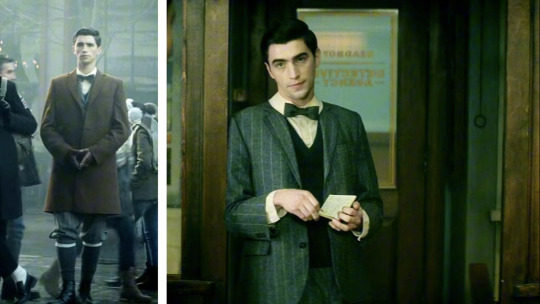
dunsmore wanted everything about charles to feel “a little bit cool and underground,” from his union jack and the who bull’s-eye patches to his checkerboard pins. his little cross earring and chain on the outside of his shirt are also meant to be homages to the ’80s.
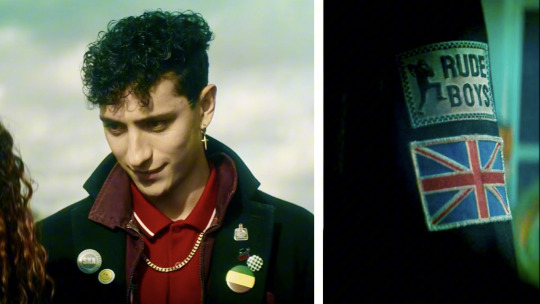
in the show, crystal’s hero color is purple, which you’ll notice in her velvet coat and long silk letterman jacket, which dunsmore thought of as a psychic cloak with hand-embroidered patches, including the wilting rose of england.
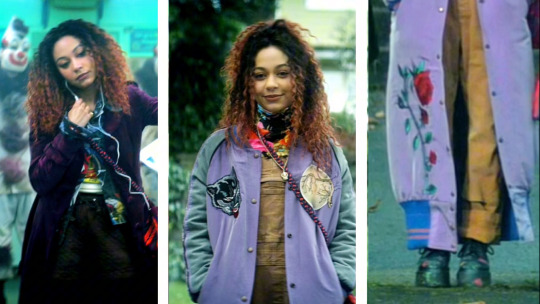
her brown trench coat represents an explosion of everything going on in her mind. dunsmore decided the scribbled words and drawings are a result of crystal writing all over it to express her inner turmoil. there are even lyrics on there from the song she’s listening to on the tube when she meets the dead boys.
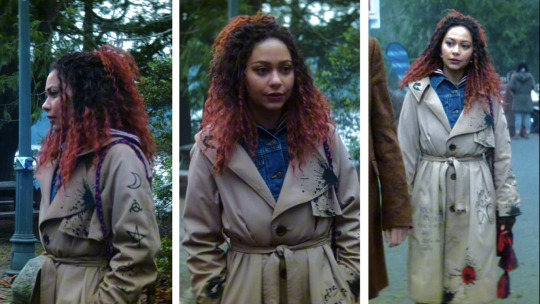
david’s connection with crystal seeps into her wardrobe, too. since david wears a flower shirt, dunsmore’s team hand-painted flowers onto crystal’s black boots. and niko is wearing a dark sweater with flowers on it when we first meet her, as an homage to crystal. the costume department also drew the same rune pattern the dead boys use to exorcise david in episode 1 onto crystal’s trench coat and on the tab of her wool bomber jacket. “so she’s always got some sort of protection,” says dunmore.

every color niko wears is inspired by what’s happening in that episode, from the green post-sprite exodus to blue when she’s feeling sad. niko only wears a white look, with nods to her japanese heritage, in the finale as a reset. the charms on her obi belt represent the colors she’s worn all season.
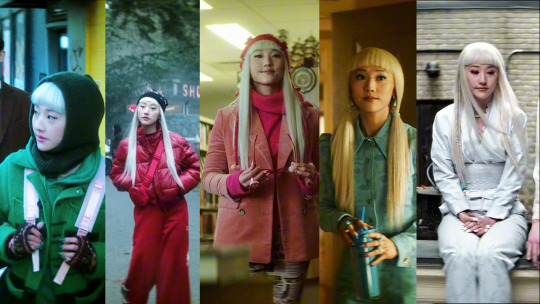
night nurse is someone who’s in control all the time and likes things to be in their proper place. dunsmore looked to vivienne westwood for inspiration, since everything in night nurse’s world is a bit exaggerated. (by the way, niko’s orange monochromatic look is a nod to her scenes with night nurse and night nurse’s red hair.)

since david is a demon, he finds a london boy that looks cool enough for crystal to find attractive. that meant dunsmore dressing him in a shearling jacket you’d find in “all the guy ritchie movies,” black pants and creeper shoes. the costumer’s mood board for “david the d” featured radiohead and amy winehouse and her husband blake, who often wore hats similar to the one you see david wearing in the show.
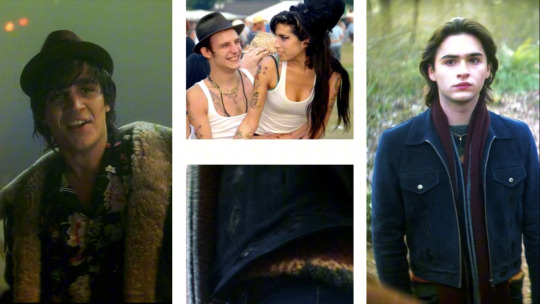
pay close attention to monty’s leather jacket and you just might spot an inlaid crow feather or two.
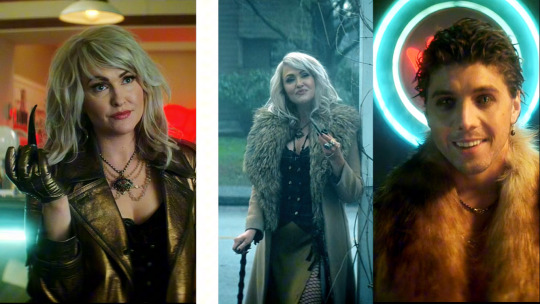
it’s not only esther who wears clothes with a gilt, old-gold color — cat king and night nurse also do as a nod to their villainy. (esther and cat king also have similar fur coats.) amidst her beauty, dunsmore wanted esther to be a little rough around the edges. she wears a cuff around her hand that’s adorned with a snake and a ring with teeth all around it to represent the teeth she’s collecting from all the little girls. her eye necklace is meant to be her witch pendant.

mischievous as ever, cat king has (cat) eyes everywhere and is aware of edwin’s affection for charles. so he wears charles’ socks the first time he meets edwin.
#well this is a very long post with an analysis of each character's costumes#charles rowland#dead boy detectives#edwin paine#edwin payne#niko sasaki#crystal palace#monty the crow#esther finch#night nurse#george rexstrew#jayden revri#payneland#painland
3K notes
·
View notes
Text
Okay, so we know that Charles' polo goes red>burgundy>black and back by the end of the season.
Because there's so much going on, I always missed the exact transitions. This time I specifically tracked them down. (Apologies if this has already been done.)
Charles shirt is bright red through the majority of the Devlin House, even in Hope's Diary scene, when he opens up to Crystal.
Even when he first swings at Mr. Devlin and gets knocked back, his shirt is red.

The very subtle shift to burgundy is after he disappears and first reappears in the loop.

It remains burgundy throughout the entire lighthouse leapers episode and beginning of the two dead dragons.
I finally realized the very last moment we see of Charles in the burgundy is with Crystal. She tells him after the confusing makeout night, "But I think we should be friends," and kind-hearted Charles, of course, respects that and puts on a friendly smile.

It's difficult to see in the next scene with him because of his jacket, the angle he sits at on the ladder, and the lighting, but it's immediately after that when we first see him in the black polo.

My brother in death, you are NOT doing well.
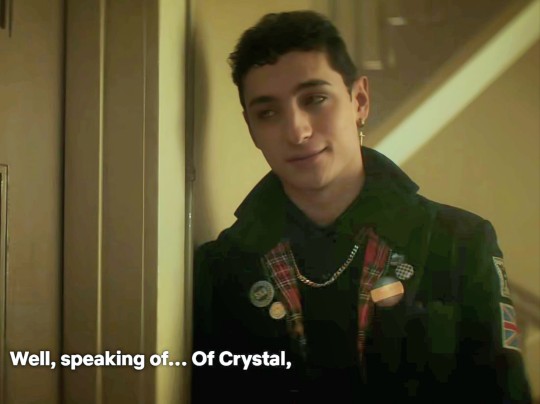
here's another song from Jayden Revri's official Charles playlist, that I think is about this conflict with Crystal:
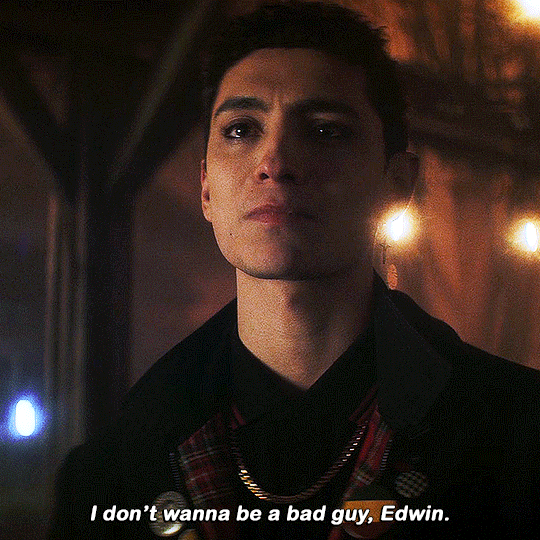
His shirt is still black during the "I don't wanna be a bad guy" scene.
After Edwin's affirmation of Charles' inherent goodness, it is directly after this scene that the shirt goes back to burgundy!!!

He's still wearing the burgundy during the confession:

BUT IT GOES BACK TO BRIGHT RED LITERALLY RIGHT AFTER EDWIN'S CONFESSION AND THEY ESCAPE HELL TOGETHER!
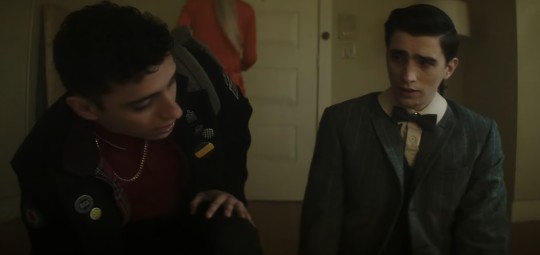

Yo I equally love Cryland and Payneland but the show canonly said "Crystal hit him in the loneliness and Edwin hit him in the loved"
#Spotify#text post#charles rowland#crystal palace#cryland#love cryland but i do accept the misunderstanding conflict angst#costume design#dead boy detectives#dbda#dead boy detective agency#makeout scene#but i think we should be friends for now#the case of the devlin house#the case of the lighthouse leapers#the case of the two dead dragons#scene analysis#reference#if this has already been pointed out sorry but these are for my own notes at least#the case of the creeping forest#the case of the very long stairway#dude i've never been this emotional about a fucking shirt before#this fandom is literally unravelling my sanity
1K notes
·
View notes
Text
Crystal Palace is also a Premier League football (soccer) club as well as a London area. I’ve run into confusion on Tumblr with that. The “Crystal Palace” tag is mostly Dead Boy Detectives and Kassius Nelson, but with posts every so often about football. I wonder what the heck the football fans on Tumblr think of the Dead Boy Detectives Crystal Palace gifsets they must keep stumbling across ever since April 2024.
I just learned that Crystal Palace was a real place (apparently it’s a region in London known for having a park with dinosaur sculptures, the birthplace of a fictional socialist utopia, and the meeting place of a historic Sherlock Holmes fan club. Literally the most Tumblr thing I’ve ever heard.) Maybe I’m just a stupid American who’s late on the pickup, but this is hilarious. Imagine if when Crystal officially moves to London, she sets up shop in Crystal Palace. She’d be Crystal Palace, the psychic of Crystal Palace. It’d be amazing. I bet Niko would love it to, if they realive her, she’d definitely be into the village feel and random dinosaur stuff.
36 notes
·
View notes
Text
i'm really sorry to be that person, but isn't it funny how in the devlin house, what was essentially charles' personal hell, edwin had to cover crystal's mouth to silence her scream, and in actual hell, edwin had to cover charles' mouth to silence his scream? how edwin is forced to be stoic and reserved around almost everyone else, how people think he is detached or emotionless, and he has to silence their screams? how he is forced to be "the adult" at sixteen because he is the only one who knows what the danger is? how he has to rescue charles from his hell, how he has to keep charles safe in actual hell, how he begs simon to be quiet in his part of hell, how he had to be quiet about his sexuality, how edwin's entire life he has been silenced, how edwin's entire afterlife he has been silencing other people, how the only person to see him smile with teeth is charles?
#god fucking forbid these bisexuals shut up#like guys there is a MISERY WRAITH there is a giant spider demon doll#now is not the time#dead boy detectives#edwin payne#charles rowland#save dead boy detectives#payneland#analysis#renew dead boy detectives#crystal palace
726 notes
·
View notes
Text
I think Charles grins fondly when Edwin's being a bitch because he genuinely thinks it's hilarious and adorable. But I also think he admires the shit out of Edwin's unwillingness to tone himself down or file off his sharp edges. Charles needs to be liked so much, and he spends so much time setting himself aside and tying himself in knots to be what other people need, and Edwin just doesn't. He is exactly and entirely his snippy bitchy self and everyone else can take it or leave it. I think there's something exhilarating in that for Charles - both a sense that by attaching himself to Edwin he can borrow some of that fearlessness about outside judgments, and a thrill of knowing that Edwin can ignore everyone else's opinion because Charles is always, entirely, inarguably enough for him.
And there are downsides to that dynamic. Charles works really hard to manage the vibe, and the fact that Edwin doesn't really do that back (isn't equipped to do it back, because he doesn't read people and intuit what they need from him the way Charles does) sometimes leaves him feeling like he's carrying that weight alone. (who else is gonna keep spirits up? you?)
But also there's a reason Charles is drawn to stubborn difficult people with sharp edges who don't apologise for who they are, and I don't think he'd give up Edwin's bitchiness for anything.
#DeadBoyDetectives#Charles Rowland#Edwin Payne#Crystal Palace#DBDA#Dead Boy Detectives#character analysis#fatal rambles
1K notes
·
View notes
Text
Okay gang, I noticed something super intriguing in my recent weekend rewatch of Dead Boy Detectives!
In Episode 4 when the night nurse goes into Charles' mind there's a consistent detail in his memories that I haven't seen anyone point out: not all of Charles' five schoolmates throw stones at him when he's in the lake.
Two boys are positioned slightly off to the left side of the screen, watching and making no move to stop the others, but they do not directly harm Charles at any point.
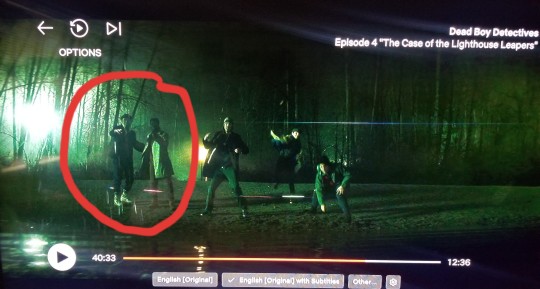
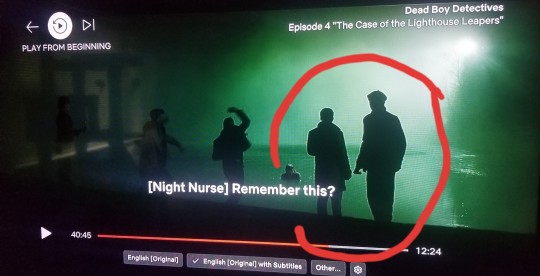
I know this doesn't seem particularly interesting in and of itself, but it quickly becomes more interesting when the Night Nurse asks Charles "What could possibly have made [his] friends turn on [him] like this," and we flash forward to the next memory, a visual response to her question. In this memory, we see Charles standing up to all of his so-called "friends" who are senselessly beating up on a boy from Pakistan and...
Wait - actually, no - not all of his friends...
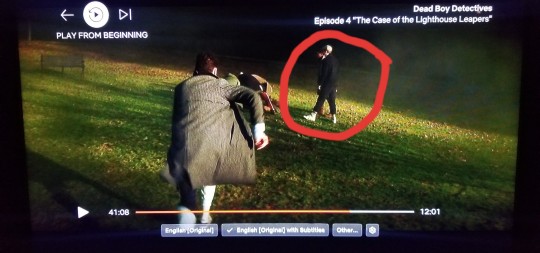
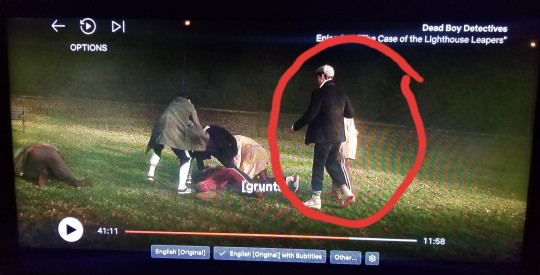
Yet again, two boys have been intentionally set apart from the group and yes, it is the same two boys who stood off to the side and watched Charles be harmed (ultimately killed) in the previous scene. The juxtaposition of these scenes begins to feel even more intentional when the perspective flips and we see the scene how Charles was seeing it, with the passive boys on the left and the boys engaging in violence on the right.
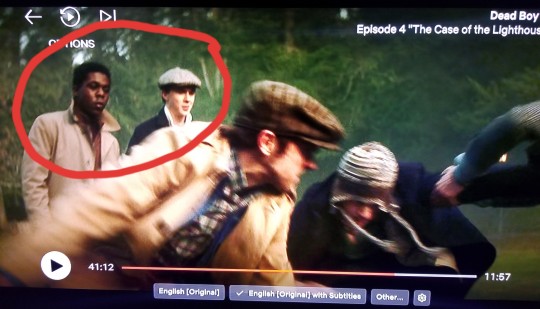
This scene is much brighter so we get a really good look at their faces here, but both of them go through a myriad of facial expressions/reactions in quick succession that are challenging to discern with 100% certainty. But with the blocking for the group being the same in both shots and the roles the boys play being the same in both shots, I feel like this had to be an intentional choice made to convey something implicitly to the audience.
That leaves me to wonder - did these boys know, deep down, that what was happening was wrong? Did they want to resist, walk away, or try to stop the violence like Charles did earlier but felt powerless to do so? It would be remiss of me not to acknowledge how one of the two "passive" boys was black: did that otherness, the same otherness that Charles felt and that boy from Pakistan surely felt, keep him from speaking up out of fear for his own safety (a valid fear, considering what we know).
Whatever the purpose, it's a really sad detail to me. Heartbreaking, actually. Edwin is 100% right when he says that the living are messy, and Crystal is right when she says that she and the boys lost their lives to boys who went too far (hers temporarily in the form of her memories, the boys completely in the form of their literal lives) because that's just it, isn't it? This show is full of moral and ethical conversations surrounding the limitations of labels like "good" and "bad" people; about capability and willingness to change; and about how our actions, whether rooted in good or bad intentions, can lead to unintended or undesired outcomes. Perhaps none of Charles' "friends" believed they would kill Charles that night; perhaps they just wanted to "rough him up" or "teach him a lesson." Perhaps none of Edwin's bullies could have anticipated that the ritual sacrifice "prank" would do anything more than scare a boy they perceived as different, effeminate ("Mary Ann"), and they certainly couldn't have known it would lead to years of torture and suffering in hell for not just Edwin, but for themselves as well. But it doesn't matter, and it doesn't excuse what they did. The boys who stood to the side and watched Charles die, and who watched their fellow "mates" beat on another boy prior to that, may not have thrown a single punch, but it didn't matter - the damage was done. They still were complicit in that violence, and therefore played just as much a role in Charles' death as the boys who were throwing stones and punches. To be alive is to deal with mess, complications, baggage...to insinuate otherwise is to diminish the nuance and intention put into every choice not only in this show, but in some ways, the world at large as well. It may be a small moment, but it struck me as something that said so much without having to explicitly say anything at all. Art is a good mirror on society in this way; it makes us face the reflections of messy, complex characters and situations that we could just as likely find ourselves a part of (maybe as the "good" guy, the vicim; maybe as the "bad" guy, the bully; or maybe as the guys who just... did nothing at all. The ones who watched, who were complicit in the suffering of others for what could be a multitude of selfish or self-preserving reasons).
All that being said, the TLDR here is: considering it's the same two boys who behave the same way in both instances it feels like an intentional detail. I wonder if there's potential for one (or both) of these boys to reappear in Charles' (after)life in the future? They are likely both still alive today, in their 50s, just as Charles would be had he not been murdered. Perhaps one of these boys could die and come to the agency with regrets or unfinished business (directly involving Charles or regarding something unrelated). Maybe Charles will run into them, alive, through a different case or just on the streets of London and be overwhelmed with a sense of "That should be me, too. I should have gotten to live." I imagine he would recognize them, even in older bodies, and it would understandably affect him to have to face anyone who played a role in his death, whether they threw stones or just watched.
Orrrrrrer it could be a totally pointless detail! 😂 I'm always open-minded to the fact that after 30+ rewatches I could be overanalyzing at this point. Either way, it confounds me nonetheless and I so desperately hope we will get to explore Charles' trauma more in season 2 (🤞)... so I thought I would share my thoughts! 🖤
(Last note: please excuse the bad photo quality!! I searched meticulously for the exact screencaps I needed but couldn't find anything, so I just took pictures of my tv screen with my phone lol.)
#dead boy detectives#dbda#charles rowland#edwin payne#crystal palace#dbda analysis#the dead boy detectives#the dead boy detective agency#the night nurse#I'm sorry this is so long I got emotional and needed to share#This show is so important to me I need a season 2 NOW
388 notes
·
View notes
Text
I think the reason why there are so many amazing ships in Dead Boy Detectives is because the show manages to show different versions of love/lust/devotion through different relationships all characters have.
Like, love triangles have been doing the whole "a girl has to choose between two guys who each being out a different side of her" for over a decade in popular media, some more, some less successfully. But the pitfall they often fall into is that those differences seem very shallow and often ignore the other aspect of the main person who have to choose between the love interests.
Dead Boy Detectives makes sure to not do that.
When we look at how Charles is with Crystal vs how he is with Edwin, we can clearly see the difference. In the beginning of his and Crystal's dynamic, he is flirtier and puts more if a bravado, but he pretty quickly opens up to her. Because he sees that she very quickly sees past his facade he puts up with his constant happy-go-lucky persona. Only when he starts opening up to her and showing his emotions does their relationship progress. Because after David, Crystal needs someone who can be emotionally vulnerable with her and in turn, Charles offers her the same, and offers her a safe space.
In contrast, we see that Charles is more at ease around Edwin. They know each other deeply, and are also woven into each other at this point. It's easy, like breathing. One thing it doesn't do is challenge either of them from the status quo they have built over the years. But there is a sense of ease there, and such devotion. There is no question about what they would do for each other because the answer is everything.
That said, while they both bring out different sides of Charles, those sides of him feel intricately linked to one another! Which is why Crystal coming into the pictures begins changing Charles' relationship with Edwin as well! It brings to light things they have ignored. And in turn, Charles' clear and unwavering devotion and loyalty to Edwin prompts Crystal to learn it herself. To quote Jenny in ep 8, "you were about to leave and never see these boys again, but now you are going to save them"? And yes, she does exactly that.
This even has influence on Edwin and Crystal's rs directly, which I can't recall ever seeing in a love triangle before, at least not in a positive sense. But it's so clear that Charles loves both of them that the other learns to love them too, and they realize their own similarities through it, too!
As for Edwin and his many love interests, well. I know there has been a lot of debate, especially around Cat King vs Charles dyankics with Edwin, but the thing is-you are comparing apples ajd oranges here.
The Cat King is enamored, fascinated by Edwin, and yeah above all, attracted to him. This dynamic serves to challenge both of their characters' beliefs and shake up the power dynamics between them. Whenever you like the Cat King or not Edwin clearly reciprocates the attraction part, at the very least.
Charles loves Edwin and is devoted to him and Edwin to him turn, as discussed above. What is difficult about their relationship is that it became stagnant due to lack of communication, which is why they needed other relationships to shake up that dynamic.
But to address the most prominent comparison I saw, which is the Cat King saying he'll wait for Edwin vs Charles going to Hell to save him.
Both are types of devotion, is the thing. A profession of love, if you will. To this day, we consider Penelope a faithful, loving and devoted wife for waiting for Odyssey for 20 years. Cat King saying he'd wait for Edwin isn't any small confession, given he is aware it could take decades, if not more.
Don't get me wrong, Charles going to literal Hell to save Edwin and succeeding where Orpheus and Eurydice failed is an enormous success and a way to show you love someone. I am not minimalizing that at all.
I am just saying that, for who these characters are and given their rs with Edwin, they did exactly what they were supposed to. They expressed in which ways Edwin had influenced them and what they can offer him if that dynamic becomes romantic.
Cat King represents experience, patience. As an immortal he has all the time in the world to wait for Edwin to return from hell, because he believes Edwin is strong enough to return on his own.
Charles represents love that breaks all obstacles in their way. He goes to save Edwin because he believes Edwin deserves to be helped in the way he helps others. He deserves to be saved.
My point is, there is no better of worse way of loving someone. The character in the love triangle choose the person that better alignes with who they are and who they wish to be as a person. So yes, you are absolutely allowed to say "I think this character would choose person a because it alignes better with their character development" but comparing the two as one being superior is kinda pointless imo? Exploring different dynamic of a character is the goal here, right? Either through canon or fanon.
...I was gonna talk about Crystal/Niko and Edwin/Monty too but this post got away from me to uhh. Might do another one if anyone is interested but in their way! I adore the way DBDA explores different sides of characters while still making them feel like a fully rounded person and doesn't shy away from letting one rs influence other rs character has.
#dead boy detectives#charles rowland#crystal palace#edwin payne#the cat king#payneland#cryland#catwin#rio's rambly analysis
274 notes
·
View notes
Text
Edwin rarely initiates touch. He touches people when that are in danger or in response to the other person touching him first, but barely never does he initiate touch out of care for someone. That's what makes this scenes so important to me:



(First and only time he is touching them)
And then there's Charles, who always initiates that constant casual and cozy contact they have. So the few times Edwin is the one starting it seem so much more powerful to me now...




And for those of you wondering about Crystal, he does touch her a few times (he touches her the most out of the others, apart from Charles), but just mainly because they are on a case and she has a life to lose or she is the one touching him, so... I didn't add her... I'm sorry Crystal, Edwin just needs a bit more time to show he cares about you in that way.
#i'm sorry crystal#i love you#yes. i did rewatch all dbda just for this post#yes. it was only an excuse.#touch#edwin paine#edwin payne#tck#the cat king#niko sasaki#simon dbda#crystal palace#charles rowland#dead boy detectives#dbda#save dead boy detectives#dbda meta#dbda analysis
146 notes
·
View notes
Text
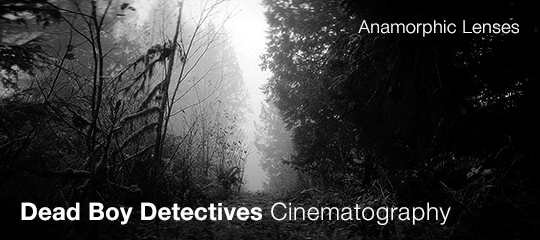
Part 1 of looking into some of the technical cinematography aspects of the show
(or, why does Dead Boy Detectives look Like That?)
(update 6/30/24: there's now a part 2! check it out here)
Dead Boy Detectives has some interesting things going on with the cameras. You probably noticed it at some point while watching the show. Whether it was the weird blurs or the sort-of-fisheye, there’s something about many of the shots that doesn’t look the way many people expect TV shows to look.
The main reason why is because it uses an anamorphic lens instead of a spherical lens. These lenses are pretty different from spherical lenses, and the recent rise of anamorphic lenses in TV has not been without some pushback, as viewers unaccustomed to them may find the look weird, distorted, or that it pulls their focus away from the content. Whether you enjoy how Dead Boy Detectives looks or find the cinematography distracting, this post is designed to explain the different effects that the lens has on the show.
This post is very long and very graphics heavy (I made lots of gifs to illustrate my points) so the rest is under a read more.
What is an anamorphic lens and what is it used for?
To begin with, a bit of history and technical info. Say you’re making a movie at most any point before the mid-'90s and you want it to be widescreen. However, the 35mm film you’re shooting on has a smaller aspect ratio (closer to a square than widescreen). You could use letterboxing (black bars on top and bottom) but then you waste the top and bottom parts of the film, and it ends up being slightly lower in ‘resolution.’ The solution: use a lens that records the full height onto the film, but squishes the picture horizontally so that it fills up the whole film frame without any letterboxing. Then, a projector (or a computer) can stretch it out again to display the whole thing in widescreen. The kind of lens that can do that is an anamorphic lens. They've technically been around since before the 1920s but were mostly used between the 1950s and the 1990s.
Up until sort of recently, television networks broadcasted using a smaller aspect ratio that they required shows to be in, and TV shows were not given the kind of cinematography budgets that movies were afforded. Anamorphic lenses are expensive and for widescreen, so they really just weren’t used for TV shows. Instead, a spherical lens was used, which is just the standard lens you think of when you picture a camera lens.
In the 90s, new flat/spherical film formats came out that allowed for widescreen (one of the popular ones being Super 35) caused anamorphic lenses to drastically drop in popularity. However, there has been a recent resurgence, one that you’ve probably subconsciously noticed in both film and television.
In the last 10-15 years, TV has been given larger and larger budgets. Additionally, the rise of streaming services and the use of phones and computers to watch shows rather than actual televisions has meant that networks have started allowing wider aspect ratios, paving the way for anamorphic lenses to begin to be used for series.
The history of these lens’ usage means they’re associated with a ‘cinematic’ look. They have a lot of characteristic effects that are not really ‘natural’ and depending on the viewer, this either enhances the experience or detracts from it.
Lots of recent series have been embracing these lenses (to varying degrees of success), including The Witcher, Sandman, Shōgun, Narcos: Mexico, The Mandalorian, Andor and Chilling Adventures of Sabrina. Doctor Who also started using anamorphic lenses at the switch to the 13th Doctor, so that may be a good reference point. For some of these, it’s a very subtle look, for others, the lens choice is glaringly obvious and overdone (I’m looking at you Sabrina), and sometimes, as is the case with Dead Boy Detectives, it’s really obvious but it remains an effective and compelling choice.
Why use an anamorphic lens in the 21st century when you could just use a spherical lens?
Anamorphic lenses create a look that some filmmakers desire, whether for their associations with a more cinematic look or their sometimes unusual quirks. In a film and tv world filled with spherical lenses that are nice, clean, and precise, anamorphic lenses introduce some irregularity and character. Making an informed decision on what kind of lens to use can enhance different themes of the work.
I want to briefly bring up Moonlight to illustrate this point. Go watch the trailer if you haven’t seen it, and you’ll probably see some parallels with the cinematography of Dead Boy Detectives. There’s less of the ‘radial’ look, but otherwise, there’s a lot of the same kinds of things. Moonlight uses an anamorphic lens and it makes the whole thing look dream-like, nostalgic, and a bit like we’re getting into the character’s heads. To me, it indicates that the story is being filtered through people. We’re not detached from the characters, observing them. The story we are watching is personal, emotional, and necessitates intimacy.
Dead Boy Detectives really benefits from the same visual effects. This is not because it enhances a dream-like or nostalgic quality, but because in the context of the show, it makes it look a bit otherworldly, magical, or otherwise supernatural. Additionally, the constraints of the lens means we get lots of focusing in on individual characters, with nice long looks at their faces allowing for more reflection on their dialogue and reactions.
So, here’s 5 different effects of anamorphic lenses to point out to you all. Starting with the one that allows us to easily identify that anamorphic lenses are being used in the first place.
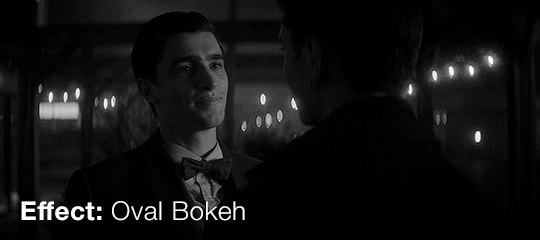
You’ve probably heard of bokeh before. It's the way the lens renders the direct sources of light that are in the background but out-of-focus. You can see in this shot of Jenny how all the string lights are not circular, but elongated. On a spherical lens, these would be round.
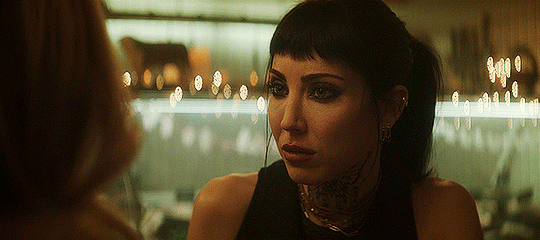
In this next shot of the Cat King, the candles around the floor are all those elliptical shapes. Additionally, lots of other details in the background that aren’t from direct light sources also have an elongated shape. This is sometimes called waterfall bokeh.

Finally, check out this shot of one of the cats. Not only are the lights in the background irregular and elongated, but if you look to the left where the ‘horizon’ line is, there's a series of elliptical shapes where the light hits the edge of the docks.
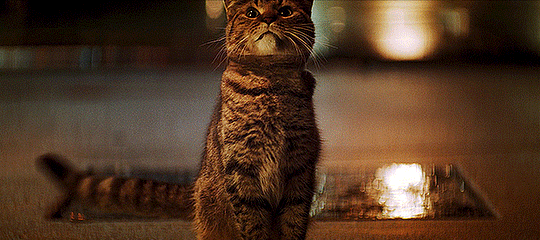
The bokeh effect is one of those things that just happens because of the lens, and makes it pretty easy to identify that an anamorphic lens is being used. Unlike some of the other effects I’ll mention, I don’t have much to say about how this does or doesn’t add to the visuals.
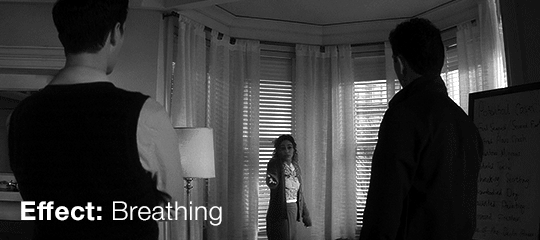
Breathing is how the field of view changes when you refocus to a subject closer or farther from the lens. While spherical lenses also breathe, there’s a much more distorted look to the breathing that occurs with an anamorphic lens.
Lets start with this shot:
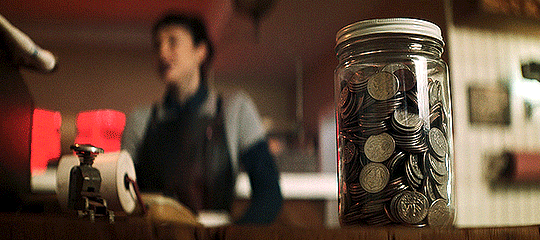
You can see how much the frame widens when the focus shifts from the jar of coins to Jenny. It affects the edges much more than the middle of the frame. Here’s the same shot, but with some of the features outlined (forgive my messy outlining, I used my laptop trackpad) so you can see the movement.
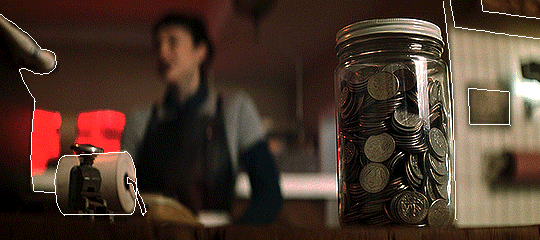
The frame widens when the focus goes from the foreground to the background. It appears like the whole shot is being stretched apart horizontally and compressed vertically.
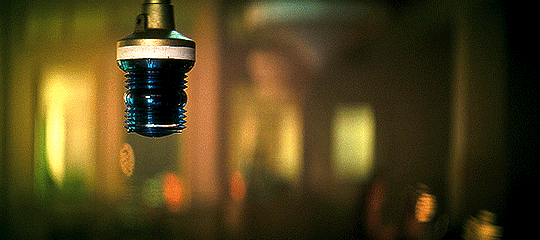
However, it also does the reverse, narrowing as the focus moves from the background to the foreground.

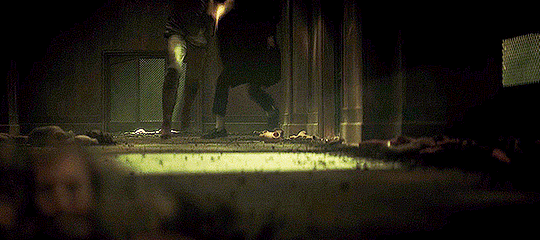
(also in that last shot of hell, notice how the two points of light in the background elongate into those oval bokeh once they are no longer in focus)
Breathing is a very dramatic way of refocusing, and it forces us to pay attention to different things. In the shot of the Night Nurse, we have a light but the important thing after it turns on is not the light but the reaction that the people have to the cause of the light. In that shot of Niko and Edwin, it’s telling us: listen to Niko. In the shot of hell, it’s not letting us forget what the characters are running from.
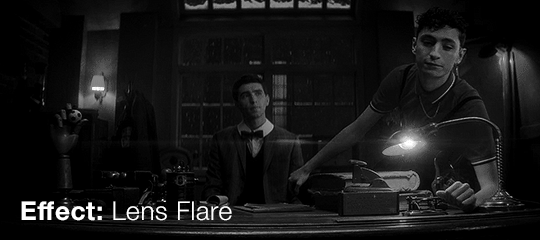
The next effect is the lens flare. You can get a lens flare from a spherical lens too, but anamorphic lenses typically generate strong, horizontal flares. A spherical lens would typically create a more radial flare, with multiple lines shooting out in different directions from the light source like rays from the sun.
We see these all over the show, sometimes they’re very prominent, such as in these shots with obvious light sources:
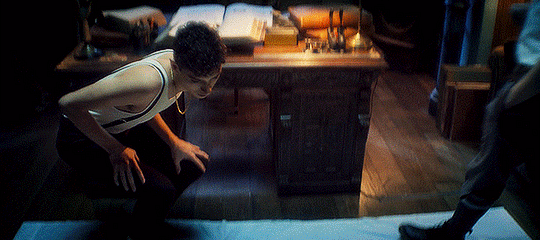
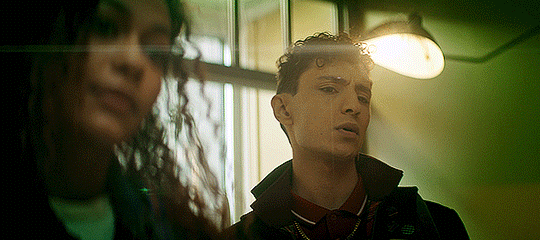
And sometimes they're a bit more subtle. Take this shot of Edwin, Charles, and Crystal on the dock:
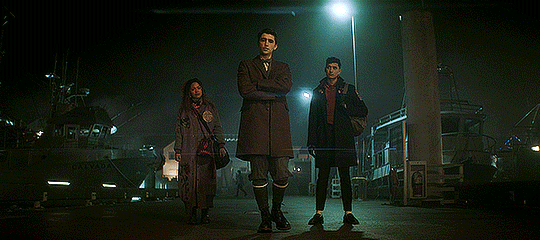
While the lens flare at the top of the frame has a clear source, there’s a bunch of other horizontal lines cutting across near the middle and bottom half of the frame. These likely come from light sources outside of the frame.
Some directors, cinematographers, and other creators really like anamorphic flares. Others don’t. For a show with so many dark scenes that have colorful and dramatic lighting, the lens flares seem to enhance this. They are also a constant reminder of the interaction between the lights and the camera, kind of a fingerprint of the production. Sure, they make it seem more ‘cinematic,’ but I think they also ground us in the physicality of the production. (Kind of ironic given the lack of physicality of the main characters, and also you could consider the flares themselves to be the ghosts of the lights and the camera!)
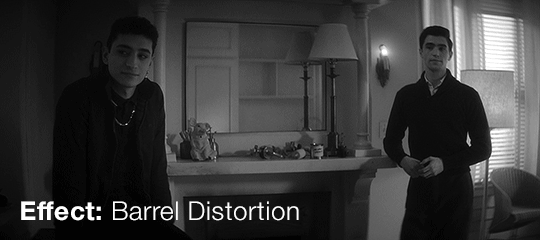
Barrel distortion is where we start getting into why exactly the show looks the way it does. This is basically a subtle fisheye effect. Because of the squishing and stretching of the footage, anamorphic lenses have more distortion than spherical lenses, and it is strongest around the edges.
You can see it most clearly in shots that have lots of vertical lines. They are relatively straight in the middle of the frame, but the closer to the edges, the more they are warped.
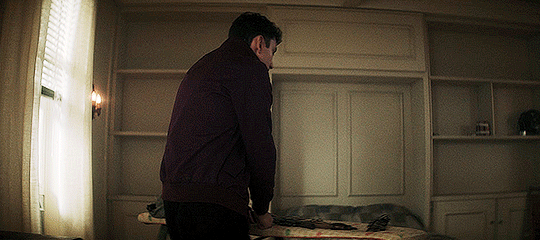
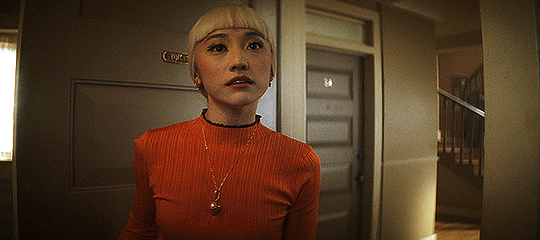
Looking at that shame shot of Niko in the bathroom, I have set it to stop at 3 different spots. Pay attention to the shape of the edge of the door.
At the start, it’s curved outward, like an open parentheses: (
Then, in the middle, it’s a vertical line: |
Finally, as the door passes all the way across the frame to the opposite side, it curves inward, like a closed parentheses: )
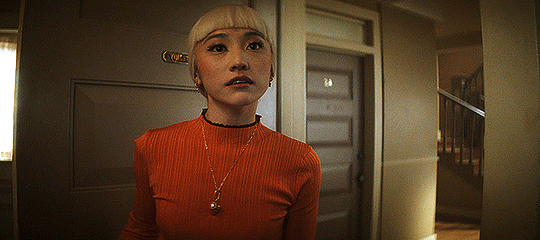
Again, notice how the lines in this shot of the Lost & Found Department change as they move from the outside towards the center. The door has an outward bulge at the beginning but becomes more 'normal’ shaped as it gets further away.

Anamorphic lenses can also have a pretty shallow depth of field and it’s used a lot in this show which is why we get a lot of those centered close-ups, and why we get that ‘radial blur.’
The center of the frame is where the actors are least likely to be distorted, meaning its easiest to have just one character in the dead center (pun intended). With a shallow depth of field, the background is out of focus, and since the actor is in the center, the background gets the most affected by the barrel distortion, leading to the sense that the background has been radially blurred.
This blurred background with a strong, centered foreground really makes objects in the foreground pop. We are then able to really focus in on different objects and characters. It brings immediacy and intimacy. Here, we have nothing to do but consider Charles. He isn’t speaking so we must consider his reaction to what’s being said.
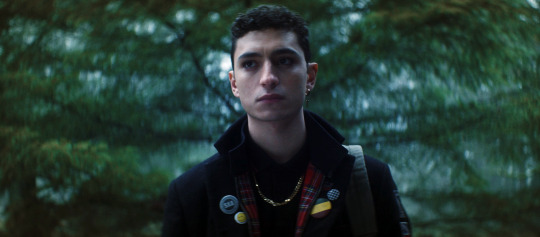
Also, the further a character is from the center of a shot, the more they are distorted, such as Edwin and Charles in this still:

This kind of distortion definitely lends a more unnatural look to the shots, which definitely supports a show about ghosts and the supernatural. If the subjects are able to see things in our world in a way the viewers cannot, then why display the physical world the way we see it?
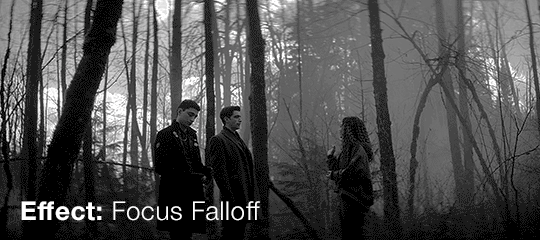
Finally, we have focus falloff. This is (like some of the other effects) a distortion that occurs around the edges. Here, the focus decreases the further from the center of the frame even if they’re all about the same distance from the camera.
In this shot of the Tongue & Tail, the sign 'Butcher Shop’ is clear and legible. But imagine if that sign was up in the top left or right corners, where things start to get blurry. We probably wouldn’t be able to read it.
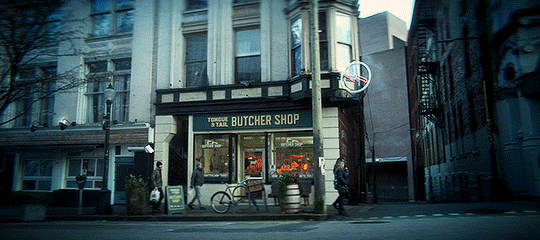
It's also visible in this shot of Edwin. Not only does the floor get blurrier the further you get from the center, but you can see how the rope is less in focus in very top and very bottom of the frame.
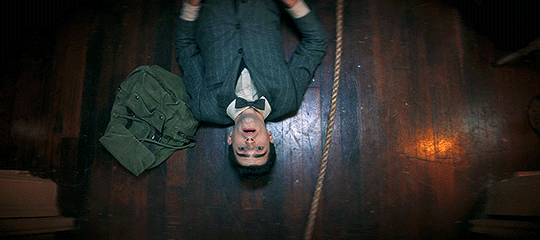
The falloff (combined with the barrel distortion) is how we get the really unique dream-like look of the Edwin and Niko scene on the roof in Episode 8. (If you’re having a hard time spotting the falloff here, look at their legs)

When you start looking for falloff in this show, you start to see it everywhere. It’s easiest to spot in the corners of shots, but you can usually see all the way around the edges.
Look at the corners of this still of Edwin, or the way the top and bottom of Niko’s rent envelope aren’t as clear as the middle of it.
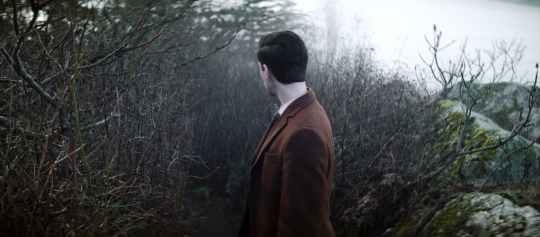
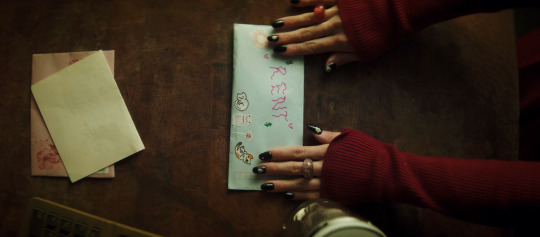
Or in this still, look at Charles’ jacket. The arm closest to the center has a much more defined line between it and the background compared to the arm closest to the edge.

This blur definitely is one of the more noticeable effects in the show, and it’s good at focusing our attention on the center of the frame. It guides the viewer exactly to what we should be looking at. We get tons of centered shots in this show because of this and the barrel distortion.
The falloff makes the show look softer and artistic, sometimes painterly or impressionistic. More than any other effect, the falloff is what makes me feel like I’m watching a dream or a vision. It puts us into the sensation of being fully immersed in a story.
I would argue that all of these effects (but especially the last two) not only enhace the supernatural aspect of the show, but they help us fall in love with the characters. They focus us on their faces, and encourage us to reflect on their motivations, reactions, and thoughts. The lens is telling us that we are not to take things at face value. It’s not letting us forget that there are multiple people and multiple stories involved, that things are blurry around the edges, and that things are not perfect and clean-cut.
-----------
Sometime in the next week or so I’ll be working on part 2, where we’ll take a closer look at the cinematography of Edwin’s flashback to 1916 in Episode 1. It's posted! Read it here.
I really wanted to highlight the work of the cinematographers, Marc Laliberté, Craig Powell, and Pierre Gill because it’s clear that there was so much care and intention put into every aspect of this show.
I’m so glad fans of this show are really embracing the work of different crew members, like the work of costume designer Kelli Dunsmore (and if you somehow haven’t seen @captainfantasticalright's posts about the costumes and other aspects of the show, please go check them out right now. My roommates and I have a kind of 'stop everything, new costume analysis dropped' attitude towards their posts, and their approach to show analysis was definiteily an inspiration for this)
If you want to read more about anamorphic lenses, the article Why ‘Shogun’ (and the Rest of TV) Is Slightly Out of Focus in The Ringer is about Shōgun and the rise of anamorphic lenses in TV (Marc Laliberté also worked on a few episodes of Shōgun) and it's a great place to start.
Finally, I want to first thank @skyvoice for these tags on one of my gifsets for semi-inspiring this post (I was already considering making this but these made it into a reality).
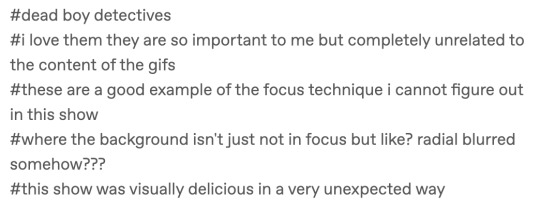
#dead boy detectives#charles rowland#edwin payne#niko sasaki#crystal palace#cinematography#cinematography analysis#dbda#mygifs#dbda meta#dead boy detectives analysis#dbdagifs
362 notes
·
View notes
Text
thinking about crystal maybe calling edwin and charles "her boys" makes me happy
#it doesn't get any more eloquent than that rn im sorry#splitting my time between prompts/painland week/summer vacation au/song analysis and au/analysis of hero and leander for them#dead boy detectives#crystal palace#crystal palace surname von hoverkraft#charles rowland#edwin payne#dbda#dead boy detective agency
203 notes
·
View notes
Text




Crystal Palace Surname Von Hoverkraft and her clothes in Dead Boy Detectives.
#dbda#dead boy detectives#crystal palace#kassius nelson#george rexstrew#jayden revri#charles rowland#edwin payne#costume analysis#kelli dunsmore
345 notes
·
View notes
Text
The parallels of Charles "I'm glad you didn't tell me" to Edwin about his impending death
And Niko's "I'm glad you told me" to Crystal about her dire situation
#i don't really have the mind for analysis right now#but anyone is free to add on#meta or comments#dead boy detectives#save dead boy detectives#renew dead boy detectives#edwin payne#charles rowland#payneland#crystal palace#niko sasaki#palasaki
132 notes
·
View notes
Text
dead boy detectives characters as art objects and sculptures; extended ---
hello, i remembered i made some subjective explanations and notes on few of my choices for this post, and i thought some folks might enjoy it. soo let's get into it.
1.
monty finch
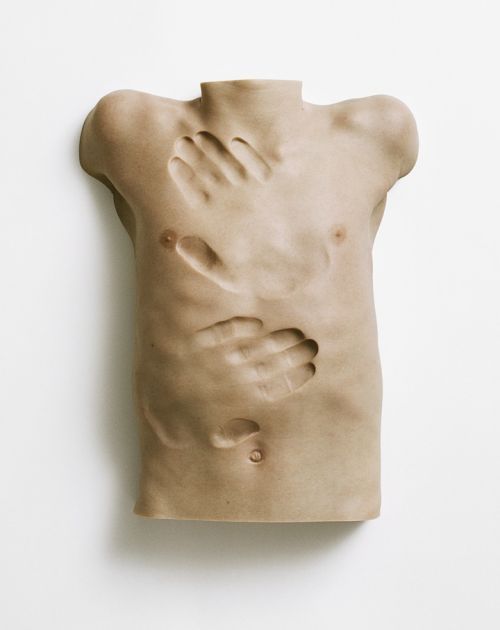
author: anders krisár
pretty self-explanatory; it's a moulded male torso with visible inprints on its skin.
anders krisár’ artistry explores the themes of loss, separation, and the condition of the psyche through the lens of a human body in duality: perfectionism meets unsettlement, skin meets marble and bronze and polyester, to create sculptures spanning geological time far beyond the living's capabilities.
monty's creation by esther was already stripped of any human agency. "he was made a boy, not a person", small, almost doll-sized, with a singular purpose: to seduce and entice the chosen dead boy into their doom. the naked skin and specifically the position of its arms are mildly erotic, but in a way that makes your skin crawl. the imprints are intimate, placed possesive; notice the thumbs digging close to especially sensitive areas like nipples and the belly button.
the latter seems to connect the "creator" to the subject, the navel here as a symbol of cruel, invasive motherhood. the fact that the torso is cut off in the middle and at the neck furthers the uncanny valley feeling of a young male body, but then again. this is a realistic portrayal. so was it ever a person? what does it have inside to make dents so profound? how deep you can press until it breaks?
--- i'm leaving out crystal and edwin (for now?), but @nicheoverhere brilliantly noticed that it was the same author for both. that was intentional! because glen martin taylor is all about taking kintsugi, which is a beautiful art form of repairing fine china and generally delicate things with veins of precious metals, but with materials like— nails. scissors. barbed wire. all ugly. the repair after a great shattering is seldom pretty after all, they really are similar in this regard. ---
2.
charles rowland
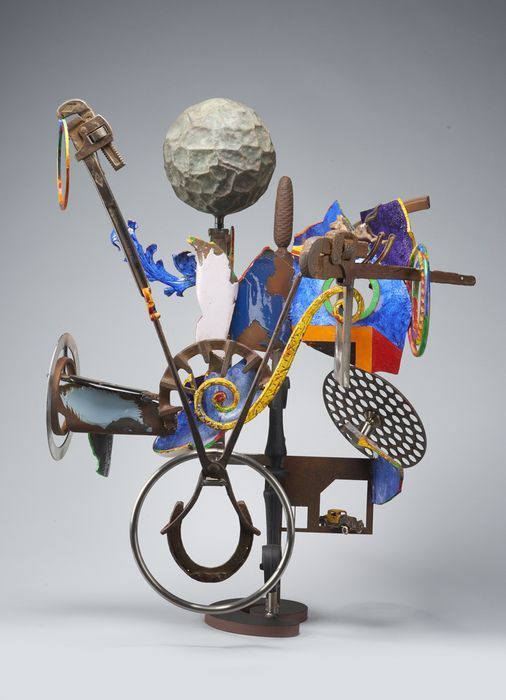
author: robert hudson
okay, strap in. this funky dreamy world belongs to robert hudson, and i picked it for charles rowland because it's all first impressions. the colours? the composition? they give you the 80s vibes, almost; like something a kid would design if you asked them what a time machine would look like. it could probably move in several ways. the pieces seem mismatched, but hold themselves together surprisingly well. or maybe you underestimate it?
it's neither big nor small. you can't tell its size at all. it's a bit overwhelming to look at, at first, and at second, and after a while, but it carries that comfortable familiarity and nostalgia for— well, nothing in particular, because the longer you look, the sadder its past seems. the bold pops of contrasting colour are fighting for your attention. they want you to like it! and yet, the major material seems to be just. rusted steel. made from tools.
and look at that botched up sphere, it wants so badly to be a perfect sphere and it knows it'll never be one. fine!! perhaps it could be a football ball instead! or maybe a head. if you close your eyes, that is. and this facing-up horseshoe? a lucky charm, made to collect good luck and keep it from falling out cause god, it needs it.
---
3.
niko sasaki

author: justin cloud
---
niko sasaki, now how do i describe her? let's start by saying— she's cleary a her. this one is a she. and there's something to be said about blooming, and femininity, and delicacy, because pink is a hopeful girly colour and a surprise and a delight.
what are you doing in a gallery, little flower, shouldn't you be at home? in a field? look how pretty you are! mind you, of course there's something wrong with her as well, but you're not sure if that is because someone messed it up, or because of a different entity alltogether. was it always half-electric? its elegance seems purposeful— the iridescent metal fits all too well with the white-pink petals— but also uncanny. and oh suddenly you can't stop looking at the stigma from which a pollen should release aaany time now.
when i look at her, at her black artificial stem and the small leaves imitating the real ones, i wonder if she doesn't want to lure me into a trap. is it her fault?
the beautiful petals seem like the only thing left real of the flower. whichever way she turns, it will probably mean— death. and flowers are ephemeral. what is a flower mounted to a wall, fortified with steel, connected with cables and enfused with electrical energy, then?
i think she's a self-preserving survivor. ---
4.
the night nurse
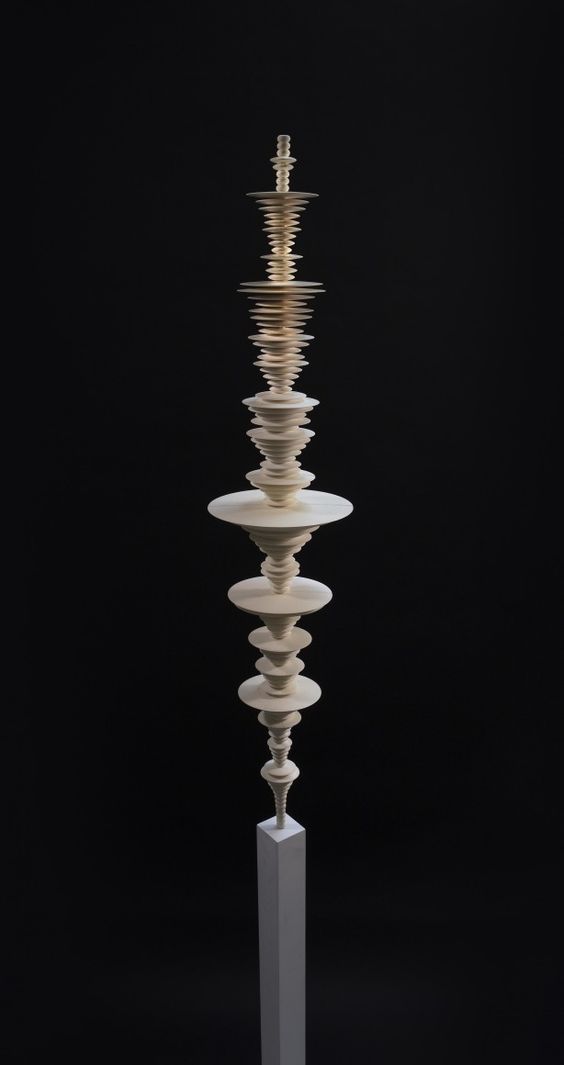
author: elizabeth turk
---
now. the night nurse.
of course it's the only piece in the collection where the background needed to be dark. no one here is older than her. there is no inoffensive, fading-into-background white for this absolute pillar of truth. or maybe something like a totem, quite protective in nature. and it's terrifying, 'cause you're immediately hit with the feeling that you're looking at something out of this realm, something you're not supposed to witness. the perspective is all wrong. is it downwards or upwards? why does it seem unstable when the pieces are so perfectly centered and seemingly well-balanced? child, you should calm down, it's not like you will destroy it with a stronger puff of air. will you?
this sculpture is called "tipping point — echoes of extinction", and it's actually a mix of technology and sculpture and sound, with elegant visualizations of the lost voices of birds and sea mammals. the author said it "was conceived in reverence to the astounding lives the species which envelop humans have lived and the mysterious ways they have contributed to our well-being. the shadows of their memory, whether a shape or a sound, have inspired this project." so the piece deals with death. moreover, it deals with murder. it records the harsh reality and makes sure the ones that suffered horribly at the hands of humans are, in a way, celebrated. but also— categorised. like epitaphs. the birdsong, once a living sign, is only visually represented by the lines of varying lenghts in 3D, and you can do nothing about it anymore, right, you can't bring back the dead, you can't help the innocent dying in any way other than— stacking them on top of each other and moving on.
---
so that's for now, i might someday write more if anyone's curious. :")
#dead boy detectives#dbda#dbda meta#dbda analysis#edwin payne#charles rowland#crystal palace#niko sasaki#the cat king#monty finch#monty the crow#the night nurse#jenny green#jenny the butcher#dbda edit#moodboard#art objects#objects#sculpture#art#character analysis#this is me trying to get into the core of them by the way. the very essence if you will#not specifically and not only their trauma but overall vibes#if we have hardcore art critics here. sorry. it's not really art crit#marcela writes#marcela watches dbda
118 notes
·
View notes